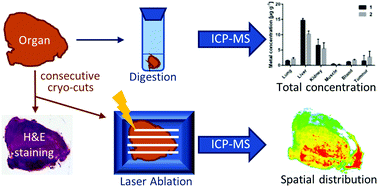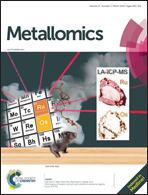Bioimaging of isosteric osmium and ruthenium anticancer agents by LA-ICP-MS
Abstract
Laser ablation-inductively coupled plasma-mass spectrometry (LA-ICP-MS) was used to study the spatial distribution of two metallodrugs with anticancer activities in vivo, namely the organoruthenium plecstatin-1 (1) and its isosteric osmium analogue (2), in liver, kidneys, muscles and tumours of treated mice bearing a CT-26 tumour after single-dose i.p. administration. To the best of our knowledge, this is the first time that the spatial distribution of an osmium drug candidate has been investigated using LA-ICP-MS in tissues. Independent measurements of the average ruthenium and osmium concentration via microwave digestion and ICP-MS in organs and tumours were in good agreement with the LA-ICP-MS results. Matrix-matched standards (MMS) ranging from 1 to 30 μg g−1 were prepared to quantify the spatial distributions of the metals and the average metal content of the MMS samples was additionally quantified by ICP-MS after microwave digestion. The recoveries for osmium and ruthenium in the MMS were 105% and 101% on average, respectively, validating the sample preparation procedure of the MMS. Preparation of MMS was carried out under an argon atmosphere to prevent oxidation of osmium-species to the volatile OsO4. The highest metal concentrations were found in the liver, followed by kidney, lung and tumour tissues, while muscles displayed only very low quantities of the respective metal. Both metallodrugs accumulated in the cortex of the kidneys more strongly compared to the medulla. Interestingly, osmium from 2 was largely located at the periphery and tissue edges, whereas ruthenium from 1 was observed to penetrate deeper into the organs and tumours.

- This article is part of the themed collection: RSC papers by GRC Metals in Medicine 2018 Speakers


 Please wait while we load your content...
Please wait while we load your content...